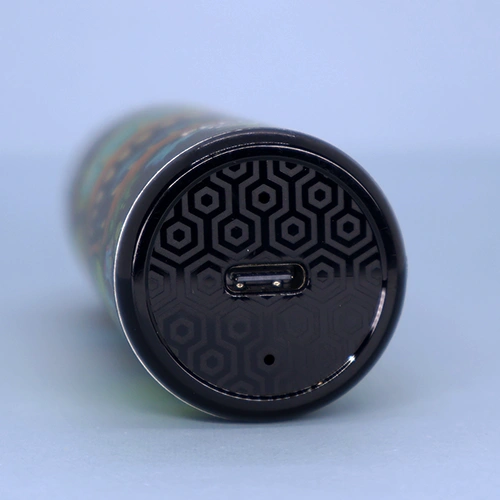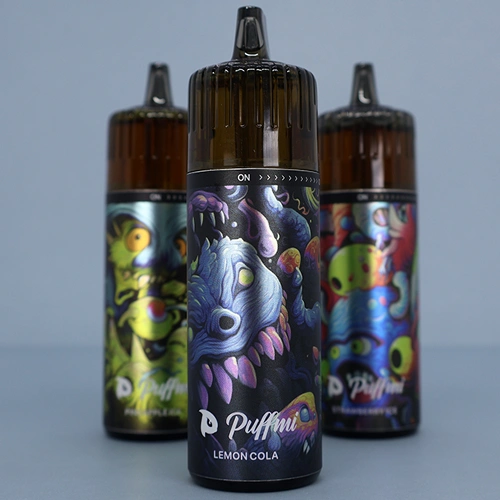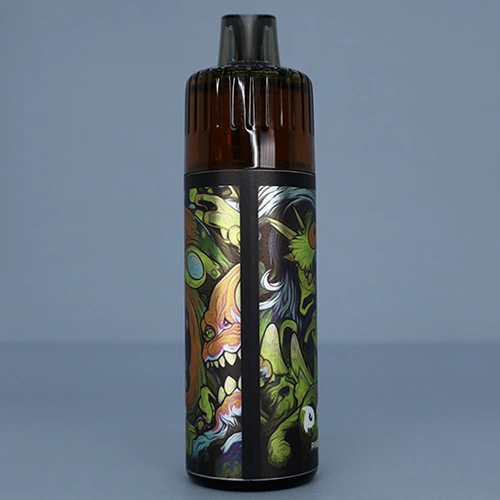PUFFMI ROAR 12000

3.5
Good
PROS
- Unique graffiti-style, monster-themed designs
- Clear e-juice tank for easy e-liquid level monitoring
- Uses FEELM Max ceramic coil which delivers great flavor
- Extremely cold and icy draw; ideal for ice vapers
- Produces a lot of vapor per puff
- MTL draw with good nicotine satisfaction from 3% strength
- All of the five flavors I tested are great
- Tank can be rotated to turn the device off; child-lock function
CONS
- Large and chunky body
- Low puff count for the size (12,000 puffs)
- Battery LED indicator is not very useful (only changes to red when nearly dead)
- Cooling will be too intense for non-ice vapers
- Strong cooling makes it hard to vape on consistently
- Only available in 30mg/ml nicotine strength
The bottom line
While the large size and graffiti monster art might turn some vapers off from the ROAR 12000, it’s probably the best vape out there for vapers craving a cold and icy draw. I would strongly suggest that vapers who don’t like cooling steer clear, or you’ll be sorely disappointed by the flavors.
There are a few things I would change about the ROAR 12000, like more puffs, a smaller body, and a more useful battery LED indicator. But the flavors are good, and the cooling delivers an icy kick like I’ve never felt before. Those will be big selling points for the target audience of these vapes.
The final verdict is this: for non-ice vapers, there are better disposable options out there. However, for ice vapers looking for the absolute coldest draw, there isn’t another disposable that I’ve tried that hits like the ROAR 12000.
Approx. Price: N/A
Product Overview
The ROAR 12000 is another new disposable vape from Puffmi, a vaping brand that has been on an absolute roll with its devices.
The ROAR 12000 is a low-medium puff disposable that offers up to 12000 puffs and comes with a built-in 630mAh battery that is rechargeable with Type-C charging. As of the time of writing this review, these disposables are only available in 30mg/ml nicotine strength.
So, what sets the ROAR 12000 apart from other disposables? For such a simple-looking disposable, there’s actually a lot. It has a clear e-juice tank for easier monitoring and delivers a super cold and icy draw from all thirteen available flavors.
Our team has reviewed many of Puffmi’s devices over the years. Most recently, we reviewed the new DURA 9000 and DURA 18000, both of which are drastically different from the ROAR 12000. These devices impressed us, but will the ROAR 12000 do the same?
- Size: 112mm x ⌀32mm
- Weight: 76g
- 630mAh rechargeable battery
- Up to 12,000 Puffs
- 3% (30mg/ml) nicotine content
- Draw activated
- MTL draw
- Clear e-juice tank
- LED indicator
- 13 Flavor options
Design & Build Quality
Most disposables being released these days are square or rectangular, but the ROAR 12000 is not. It’s a tall cylindrical shape that looks more like a vape pen than anything, and it’s pretty thick too. If you took a small puff disposable from 2021 and made it massively thicker, you would end up with something like the ROAR 12000.
The 112mm height is tall but not overly so. However, the 32mm diameter places this device firmly in chunky territory, and it’s an absolute beast to hold in my hand. At 76g, it’s not too heavy, but it’s a thick device.
Puffmi has gone with graffiti-style, monster-themed art for the ROAR 12000. There are four different designs, with different color themes depending on the flavor. The art is really well done, so kudos to Puffmi, but it won’t be to everyone’s liking.
A clear e-juice tank sits right at the top of the ROAR 12000, and even though it’s lightly tinted, it’s still easy to see into. I much prefer these clear e-juice tanks over e-juice indicators because you can visually see how much e-juice you have left, rather than relying on a possibly inaccurate reading.

The tank can be rotated to turn the device on or off, and it has a series of notches that make it easier to grip. Since there’s no button-activated firing, this functions mainly as a child lock, so those with young children will be the only ones who will need to use this function. After turning on the device for the first time, I never had a reason to turn it off.
An LED lights up the tank each time you draw, but it’s not at all helpful for seeing the e-juice level because the LED shuts off the instant you stop vaping. It’s more there for the vape to look cool while you’re vaping than anything else; in any case, the e-juice level is easy enough to see without the LED.
There’s a Puffmi logo and the flavor of the device printed on the device in small font, so the branding isn’t too in-your-face.
Features

Thanks to the clear e-juice tank, I can see that there’s quite a bit of e-juice inside of the ROAR 12000, but I don’t know exactly how much there is. Puffmi doesn’t specify the capacity on the packaging, nor on their website, which is odd. But if I had to guess, I would say that there’s somewhere around 15ml of ejuice in there.
From that undetermined amount of e-juice, the ROAR 12000 has a puff rating of 12,000 puffs. For the size of the device, and for it being 2025, 12000 puffs isn’t a lot. And when you consider that there are smaller disposables out there that offer double, triple, or even four times the puffs that the ROAR 12000 is offering, it becomes apparent that this isn’t a disposable you buy purely for the longevity.
Luckily, the ROAR 12000 offers more than just its puffs. For one, it uses a FEELM Max ceramic coil inside, which we’ve actually reviewed before. This coil doesn’t use any cotton, and instead feeds e-juice straight to the ceramic coil. The benefits here are: no e-juice is wasted due to being trapped in the cotton, purer flavor, and more puffs when compared to dual mesh coils.
Flavors

Another pro for the ROAR 12000 is if you’re a vaper who likes an icy, brainfreeze-inducing draw. All five flavors that I tested have a very icy kick, to the point that I can’t take more than one or two draws at a time without my throat and head begging me to stop. This is obviously great if you like that sensation, but non-ice vapers will definitely want to pass on these disposables.
There are thirteen flavors available, and all of them but Double Mint are some sort of fruit flavor.
I’m going to describe how five of these flavors taste to me and what I think of them. However, keep in mind that just because I like a flavor does not mean that you will like it. Similarly, if I don’t like a flavor, this does not mean that you will not like it. This is solely my subjective opinion.
Pineapple Ice
There’s a nice pineapple flavor here, along with a boatload of cooling. I like that this isn’t too sweet, and leans more on the natural sweetness of pineapple to carry the flavor. It’s nothing too crazy, special, or different from other good pineapple flavors I’ve tried, but it’s very icy.
Grape Aloe
Aloe is an interesting and uncommon flavor to see, but it works well with the grape. The grape flavor is more like a grape drink than a true-to-fruit flavor, and the aloe follows the grape flavor to make an odd but juicy flavor. This flavor is less icy than Pineapple Ice, but still up there with the cooling.
Double Mint
This is a sweet mint flavor, and it’s surprisingly not even as icy as Grape Aloe. I expected this to be the flavor with the most cooling but I was wrong. The sweet mint tastes great, and there’s still a lot of cooling, but it’s just not as strong as I expected.
Strawberry ice
This flavor has a candied strawberry flavor and very, very strong cooling. This is another flavor like Pineapple Ice where the cooling will give you brain freeze nearly instantly. The strawberry flavor is good too if you like a sweeter, less-natural taste.
Lemon Cola
This is the flavor with the strongest cooling of all, and combined with the lemon and cola notes, it’s like a cola slushie with a twist. The flavor here is really excellent and Puffmi really nailed the cola taste. I wanted to vape this flavor more than I did, but the cooling made it impossible to take more than a few puffs at a time.
Battery Life & Charging

Each ROAR 12000 has a built-in 630mAh battery. On average, a charge lasted me for 2-3 days, but that’s because the iciness of the draw kept me from vaping constantly. Depending on how often you use these (and how much of an ice tolerance you have), anywhere from 1-3 days of use is a good estimate per charge.
The tank’s LED serves as a battery indicator, but it’s not a very good one. It lights up white most of the time but changes to red when the battery is getting low. And when I say getting low, I mean about to die low, so there’s not a lot of notice to grab a charger.
A three-color LED would have been much better, or at least having the red LED come on when it’s under 30% so I have a little more heads up.
These use Type-C charging and charge through a port on the bottom of each device. The 630mAh battery takes about an hour and fifteen minutes to fully charge.
How do they vape?

Just from looking at the size and shape of the ROAR 12000, I thought that these would be RDL vapes, but they’re actually for MTL. The draw is between loose and medium mouth-to-lung, but I guess you could RDL these if you kept your lips loose around the mouthpiece.
As a mainly non-ice vaper, these vapes were way too strong for my liking. The flavors themselves are good, but it was impossible for me to use these for more than a few puffs at a time without the brain-numbing cooling making me think twice. Obviously, if you’re an ice vaper who craves that cold draw, you’ll like how these hit.
The nicotine satisfaction from the 3% strength is good, and even with just a few draws from time to time, these kept me satisfied. They produce a lot of vapor with each puff, which helps with the satisfaction.
Verdict

While the large size and graffiti monster art might turn some vapers off from the ROAR 12000, it’s probably the best vape out there for vapers craving a cold and icy draw. I would strongly suggest that vapers who don’t like cooling steer clear, or you’ll be sorely disappointed by the flavors.
There are a few things I would change about the ROAR 12000, like more puffs, a smaller body, and a more useful battery LED indicator. But the flavors are good, and the cooling delivers an icy kick like I’ve never felt before. Those will be big selling points for the target audience of these vapes.
The final verdict is this: for non-ice vapers, there are better disposable options out there. However, for ice vapers looking for the absolute coldest draw, there isn’t another disposable that I’ve tried that hits like the ROAR 12000.
Approx. Price: N/A















Add comment